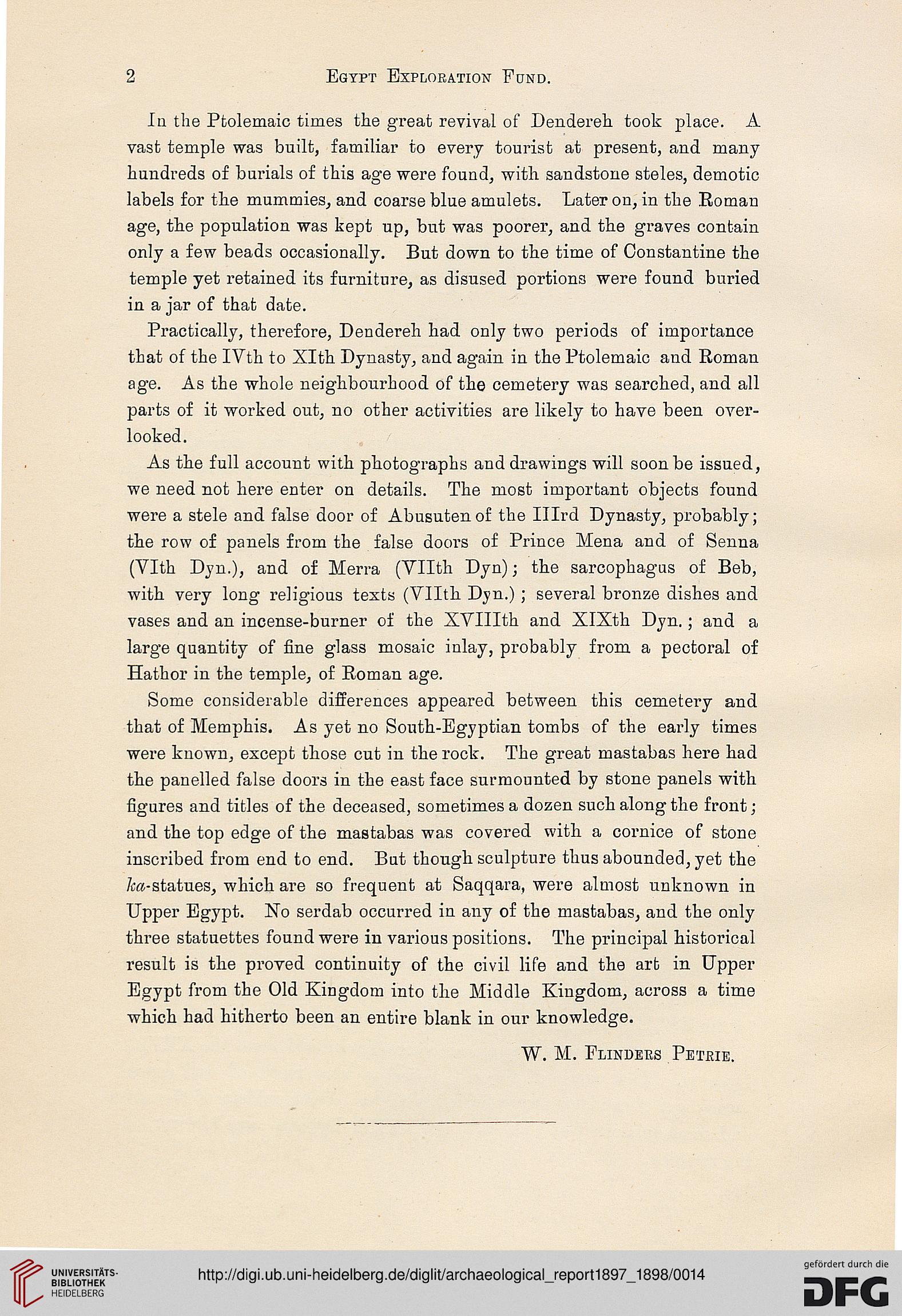2
Egypt Exploration Fund.
In the Ptolemaic times the great revival of Dendereh took place. A
vast temple was built, familiar to every tourist at present, and many
hundreds of burials of this age were found, with sandstone steles, demotic
labels for the mummies, and coarse blue amulets. Later on, in the Roman
age, the population was kept up, but was poorer, and the graves contain
only a few beads occasionally. But down to the time of Constantine the
temple yet retained its furniture, as disused portions were found buried
in a jar of that date.
Practically, therefore, Dendereh had only two periods of importance
that of the IVth to Xlth Dynasty, and again in the Ptolemaic and Roman
age. As the whole neighbourhood of the cemetery was searched, and all
parts of it worked out, no other activities are likely to have been over-
looked.
As the full account with photographs and drawings will soon be issued,
we need not here enter on details. The most important objects found
were a stele and false door of Abusuten of the Illrd Dynasty, probably;
the row of panels from the false doors of Prince Mena and of Senna
(Vlth Dyn.), and of Merra (Vllth Dyn); the sarcophagus of Beb,
with very long religious texts (Vllth Dyn.) ; several bronze dishes and
vases and an incense-burner of the XVIIIth and XlXth Dyn.; and a
large quantity of fine glass mosaic inlay, probably from a pectoral of
Hathor in the temple, of Roman age.
Some considerable differences appeared between this cemetery and
that of Memphis. As yet no South-Egyptian tombs of the early times
were known, except those cut in the rock. The great mastabas here had
the panelled false doors in the east face surmounted by stone panels with
figures and titles of the deceased, sometimes a dozen such along the front;
and the top edge of the mastabas was covered with a cornice of stone
inscribed from end to end. But though sculpture thus abounded, yet the
/ca-statues, which are so frequent at Saqqara, were almost unknown in
Upper Egypt. Xo serdab occurred in any of the mastabas, and the only
three statuettes found were in various positions. The principal historical
result is the proved continuity of the civil life and the art in Upper
Egypt from the Old Kingdom into the Middle Kingdom, across a time
which had hitherto been an entire blank in our knowledge.
W. M. Flinders Petrie.
Egypt Exploration Fund.
In the Ptolemaic times the great revival of Dendereh took place. A
vast temple was built, familiar to every tourist at present, and many
hundreds of burials of this age were found, with sandstone steles, demotic
labels for the mummies, and coarse blue amulets. Later on, in the Roman
age, the population was kept up, but was poorer, and the graves contain
only a few beads occasionally. But down to the time of Constantine the
temple yet retained its furniture, as disused portions were found buried
in a jar of that date.
Practically, therefore, Dendereh had only two periods of importance
that of the IVth to Xlth Dynasty, and again in the Ptolemaic and Roman
age. As the whole neighbourhood of the cemetery was searched, and all
parts of it worked out, no other activities are likely to have been over-
looked.
As the full account with photographs and drawings will soon be issued,
we need not here enter on details. The most important objects found
were a stele and false door of Abusuten of the Illrd Dynasty, probably;
the row of panels from the false doors of Prince Mena and of Senna
(Vlth Dyn.), and of Merra (Vllth Dyn); the sarcophagus of Beb,
with very long religious texts (Vllth Dyn.) ; several bronze dishes and
vases and an incense-burner of the XVIIIth and XlXth Dyn.; and a
large quantity of fine glass mosaic inlay, probably from a pectoral of
Hathor in the temple, of Roman age.
Some considerable differences appeared between this cemetery and
that of Memphis. As yet no South-Egyptian tombs of the early times
were known, except those cut in the rock. The great mastabas here had
the panelled false doors in the east face surmounted by stone panels with
figures and titles of the deceased, sometimes a dozen such along the front;
and the top edge of the mastabas was covered with a cornice of stone
inscribed from end to end. But though sculpture thus abounded, yet the
/ca-statues, which are so frequent at Saqqara, were almost unknown in
Upper Egypt. Xo serdab occurred in any of the mastabas, and the only
three statuettes found were in various positions. The principal historical
result is the proved continuity of the civil life and the art in Upper
Egypt from the Old Kingdom into the Middle Kingdom, across a time
which had hitherto been an entire blank in our knowledge.
W. M. Flinders Petrie.





